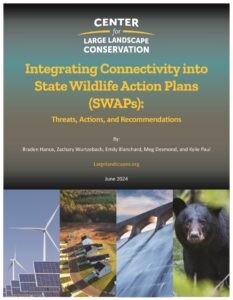Integrating Connectivity into State Wildlife Action Plans (SWAPs): Threats, Actions, and Recommendations
 Ecological connectivity is crucial for biodiversity conservation and human well-being in an era of rapid change. Connectivity conservation involves removing barriers like roads and dams and conserving landscape features that facilitate species movement. It benefits both wildlife and humans by supporting ecosystem services and reducing wildlife-vehicle conflicts.
Ecological connectivity is crucial for biodiversity conservation and human well-being in an era of rapid change. Connectivity conservation involves removing barriers like roads and dams and conserving landscape features that facilitate species movement. It benefits both wildlife and humans by supporting ecosystem services and reducing wildlife-vehicle conflicts.
Recent U.S. legislative actions at federal and state levels, such as the Bipartisan Infrastructure Law and Florida’s Wildlife Corridor Act, have demonstrated a growing bipartisan interest in connectivity conservation. These policies have led to significant funding for connectivity conservation. However, effective planning is still crucial for strategically leveraging these historic investments.
State Wildlife Action Plans (SWAPs) are therefore important vehicles for connectivity conservation. State wildlife agencies must complete SWAPs to qualify for funding from the State Wildlife Grants program (SWG), established in 2000 to support the conservation of at-risk species and their habitat. SWAPs have become recognized as “conservation blueprints” that compile the best available science, identify threats and actions, and promote coordination across various partners.
The Center for Large Landscape Conservation’s intention in authoring this report is to provide SWAP planners and partners with a comprehensive “menu” of existing connectivity actions and recommendations that can advance connectivity conservation in the face of specific threats.
Recommended citation: Hance, B., Wurtzebach, Z., Blanchard, E., Desmond, D., Paul, K. (2024). Integrating Connectivity into State Wildlife Action Plans (SWAPs): Threats, Actions, and Recommendations. Center for Large Landscape Conservation: Bozeman, MT.
Connectivity Conservation Actions: View and download a list of connectivity conservation actions from all 2015 State Wildlife Action Plans. Actions are organized and can be sorted by state, threat, and type of action (e.g., land and water management or law and policy).
Banner Photo: Black bear – Adobe Stock


